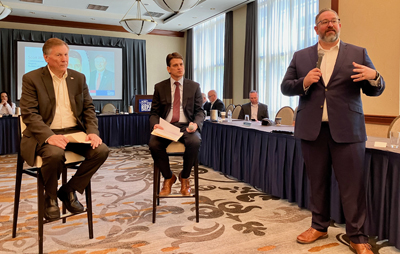During an open board meeting of the Society of Collision Repair Specialists (SCRS) in mid-April, the association’s leaders discussed what changes might occur within the estimating systems based on the blend study SCRS conducted last year.
“The research, the work, resulted in positive movement for the industry, and we’re excited to identify what the end result looks like,” said Aaron Schulenburg, executive director of the association.
Less than three weeks later, users of CCC Intelligent Solutions’ estimating system learned that by the end of the year, they will have the option to input their own refinish blend time or set their own default blend value. MOTOR Information Systems, developer of the underlying database used by CCC, said it “reviewed information from multiple sources and has concluded that the current formula reflects an estimate for one particular scenario but does not necessarily reflect the many variations encountered with modern vehicle finishes and design.”
Blend times, the company’s statement about the change reads, should be based on “the judgment of an estimator or appraiser following an on-the-spot evaluation of the specific vehicle and refinish requirements in question.”
“This is a great example of an action that we had previously requested prior to the study, that is now only taking place because of the study results and the industry support that followed,” Schulenburg said in response to MOTOR’s announced change.
SCRS believes its study last year demonstrated blending takes more time than a full panel refinish, rather than the 50% less time allocated in the three estimating systems. Schulenburg said SCRS is having “similar conversations” with the other estimating system providers as well.
Autatex, he said during April’s meeting, is “still looking at how they are going to address it,” but in the interim has showed how its system allows a user to make changes to the blend calculation.
“That’s great to have those tools, but the question still needs to be addressed because it is still our belief that the formulas aren’t representative of the tasks that are actually being performed today,” Schulenburg said.
He said the blending process also may be different than it was 30 years ago when the blend formulas were established. He said Mitchell noted two of the five paint companies in the SCRS study applied sealer on the blend edge---something called for in those companies’ training materials.
“There’s nothing in [Mitchell’s Complete Estimating Guide] that says applying sealer on the blend edge isn’t considered a blend,” Schulenburg said. “If [Mitchell] is not considering it a blend operation [when that step is done], that means they haven’t factored that operation into the times they’ve applied for blend. So it’s either not a blend, or the times need to be adjusted.”
User Agreement Opens Scan Tool Data to China
Also during the SCRS meeting, held in April in Richmond, VA, Schulenburg showed under the terms of the licensing agreement of at least one aftermarket scan tool, the user is agreeing to allow the data collected through the tool to be transferred to the company in China, “subject to China laws, including those governing the privacy and security of your information.”
The shop user is also agreeing to notify and acquire consent for such collection and transfer of vehicle data “from each customer or prospective customer,” and to the use of the information by the scan tool company “and third parties.”
Schulenburg said he’s turned the issue over to the Collision Industry Conference committee on data privacy and security. He said shops need to be aware of such end-user licensing agreements they are subject to, particularly in light of privacy agreements they may have with other entities, including insurance companies.
“Think of a USAA, that insures [four]-star generals. Think of a GEICO that insures government employees,” Schulenburg said. “What are their expectations of shops within their network to maintain the privacy of those individuals? Would they want that information shared in this manner under the jurisdiction of the People’s Republic of China? I don’t know. But it seems like it’s worth talking about as an industry.”
Insurance Commissioners Address the Industry
Issues related to “prevailing rate” were among the topics two state insurance commissioners discussed in their presentation at the SCRS meeting. Michael Bradshaw, vice chairman of the SCRS board and operations manager for his family’s North Carolina body shop, told them most insurers in his state don’t conduct labor rate surveys, and when asked, insurance company representatives tend to say they are told the prevailing rate by their supervisor, or say, “We go into shops, and that’s the rate they will take.”
“It’s not a survey. There’s no statistical data,” Bradshaw said. “That’s the biggest frustration within this industry.”
Scott White, commissioner of insurance for Virginia since 2018, acknowledged it was a topic he discussed with his staff prior to speaking at the SCRS meeting.










John Yoswick